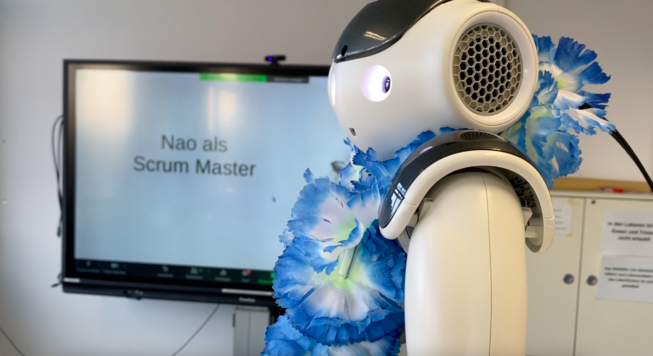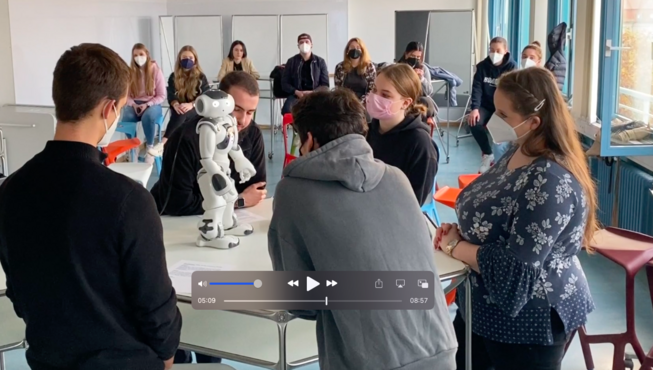NAO robot as Scrum Master
In which module and with which objective was NAO used as Scrum Master?
The NAO robot was used for the first time in the winter semester 2021/2022 as a Scrum Master in the ‘Agile Project Management’ module in the Business Administration Digital Economy degree programme under the direction of Prof. Dr Ilona Buchem.
The application ‘NAO as Scrum Master’ was programmed by student employee Niklas Bäcker from the Bachelor's degree programme Humanoid Robotics in FB VII.
The task of the NAO robot was to moderate a daily Scrum meeting, i.e. a 15-minute meeting in agile teams. NAO had the role of a Scrum Master.
The aim was to use the NAO robot to create an interactive and structured learning experience in which students could experience the daily Scrum process in practice.
Two Daily Scrum exercises were carried out with the NAO robot: one in German and one in English. This allowed the students to familiarise themselves with and experience both the German and English versions of Daily Scrum.
What was the procedure? How many participants were there?
The Daily Scrums with the NAO robot were conducted at two times (two iterations) in the winter semester 2021/2022, i.e. in November 2021 and January 2022. Around 35 students took part in the first deployment in November 2021 (hybrid, i.e. online and in person), and around 30 students took part in the second deployment in January 2022, also hybrid, i.e. online and in person.
The NAO robot in its role as Scrum Master during a Daily Scrum supported several student teams of five people each in conducting a Daily Scrum within 15 minutes and keeping the focus on the three questions of Daily Scrum Meetings, i.e:
- What have I done since yesterday to help the team achieve the (sprint) goal?
What am I doing between now and tomorrow to help the team achieve the (sprint) goal?
What is preventing me or the team from achieving the (sprint) goal?
The interaction between the students and the robot took the form of a role play and was based on a pre-prepared script. Each student had a specific role and read out part of the dialogue script. In addition to the verbal dialogues in English and German, the interaction with the robot took place through the use of tactile sensors on the robot's feet and head as well as with the help of visual feedback through the lighting of the robotic eye LEDs. The different LED colours signalled the time sequence according to the traffic light system.
While the teams of five students gradually interacted with the NAO robot, the remaining students observed what was happening. At the end, all students completed an evaluation form in which they could rate the NAO robot and the interaction with NAO during the daily scrum. A total of 47 students completed the evaluation form.

What were the results? What did the participants say?
The students rated the use of NAO as Scrum Master very positively, despite some technical difficulties during implementation. Among other things, the students were asked to rate the success of the use of NAO as Scrum Master in Daily Scrum on a scale from 1 (low) to 7 (high). The result was a mean score of M=4.74. In addition, 81% of the students surveyed stated that they would also recommend using NAO as a Scrum Master in the future. Further results showed that the students perceived the NAO robot in its role as Scrum Master as likeable, friendly, trustworthy, warm-hearted, rational and lively.
Short interviews were also conducted with some of the participants afterwards. The results of the interviews show that the students found the use of the NAO robot exciting and can imagine humanoid robots like NAO supporting teaching at the university in other areas as well. At the same time, students provided some valuable suggestions for improving the interaction, which mainly related to technical aspects, in particular better speech recognition.
Further results were documented in the publications (see list of publications below).
Publications
Buchem I. & Bäcker, N. (i. E.). NAO Robot as Scrum Master: Results from a scenario-based study on building rapport with a humanoid robot in hybrid, higher education settings. Springer International Publishing
Buchem I. & Bäcker, N. (2022). Humanoid robots in higher education: An exploratory study on applying the NAO robot as an educational technology in business studies in hybrid settings. INTED2022 Proceedings.


